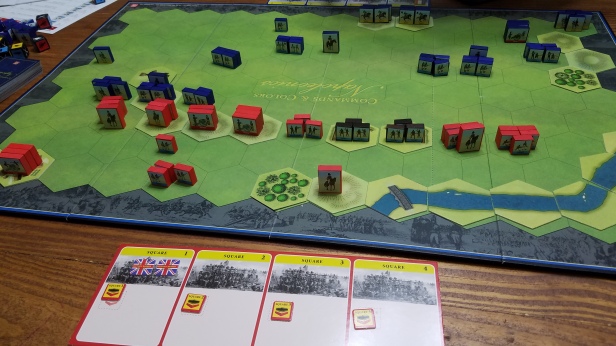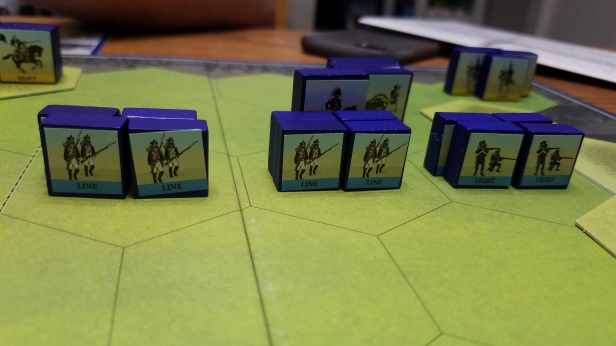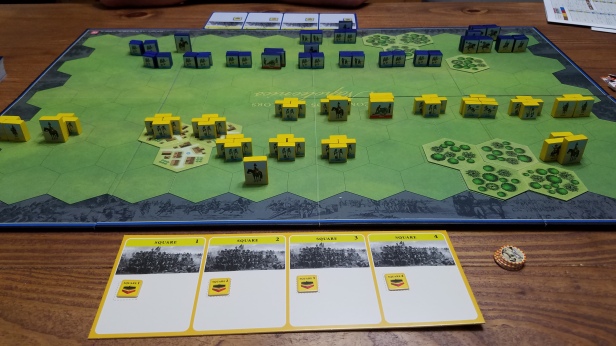Commands & Colors is a system that has been around for a long time. Most wargamers have played at least one of these games at some point or another in their gaming career, but typically far more than one. Richard Borg’s first title in the series was an old American Civil War title called Battle Cry. Designed as a simple, two player historical wargame, the system has blossomed and evolved with so many titles and iterations that at this point you can almost get whatever you want! The robust nature of the system is what speaks to it’s staying power. Nothing too fancy, you play a card to activate a number of units in a certain section of the board. They move, then attack. There’s some crunch and nuance to how all of that works but really the core is that simple. The simplicity, in my opinion, is why the series is so beloved amongst so many different gamers.
C&C: Napoleonics
This is strictly a two player game. To solo it you would just two-hand it, but there are much better games out there for solo play. For multiplayer you need the Leaders expansion, and then the epic expansion on top of that. Which effectively means you can stick multiple boards together and have massive Borodino style pitched battles. Whilst that sounds awesome, this will always be a two player game for me. It’s short, decisive and the tension from card play is a huge fun factor. You can switch sides after the scenario and play the other faction and use an aggregate score and still have time for something else in a gaming session.

The game uses blocks, but is not a block wargame in the vernacular sense. The units are not hidden, they have stickers on both sides of them so you know what units are arrayed against you. The fog-of-war comes from the card play. The board, divided into three lanes or sections, has units spread across it. You can only activate units in a lane, such as the left, center or right, if you have the card stating you can do so. A hand of cards might be debilitating to your movement and tactical options, but keeping that from your opponent might keep you from suffering an un-counterable blow! Conversely you might have the killer hand to drive the enemy back, hammer strike after hammer strike. But more often than not you’ll be sat somewhere in the middle trying to hold the line together and make an orderly advance. I enjoy trying to bluff my way through sticky situations so this is right up my alley.

Before we delved into this one, I’m not sure we’d played much in the way of Napoleonics. Indeed, we still haven’t, but its a period that I enjoy. We’ve played Hundred Days 20 and Field Commander: Napoleon, I think that’s it. I grew up watching/reading things like Sharpe, and Hornblower so whilst I may not have had the strongest grasp on the history I knew it was something I found interesting. Over the past days I’ve logged hundreds of hours into Napoleon: Total War, which has again helped me to learn and know some of the core history. So playing out all of the key battles, and reading the small historical blurbs with each scenario, are a really good way to dip your toes into such a pivotal period in European history.
Combat
In C&C: Napoleonics combat is resolved by chucking dice and these dice are chunky custom made hunks of plastic that feel so good to roll. There is a large play aid for each faction that tells you how many dice you roll based on which unit is attacking. So for example British Line infantry might fire up to two hexes away; 1 dice per block +1 (five dice at full strength). Where as they may only melee with 1 dice per block. The French line operate inversely. They melee at 1 dice per block +1, but range attack at 1 per block. The core game comes with Line, Light, three different Cavalry types, artillery, leaders and more. And that’s just for one faction. The variety of units means you can get into some great “combined arms” situations where you blast canons, fire the infantry, and then charge the remnants with the cavalry.

The dice rolled are custom ones with stickers on them. There’s no modifiers to rolls, you just hit what you roll. If I’m attacking infantry units then I’m trying to roll the infantry symbol. Cavalry for cavalry, etc. The flags are forced retreats, which instead of inflicting losses move that unit back one hex. Seriously, so simple. Mechanically almost anyone could play this game. You move units up in as much of a formation as you can muster, then try to eradicate the enemy. Some missions have other VP hexes or conditions but you’ll always need to do a fair amount of enemy damage too. Now, tactically speaking I think this is one of the more complex games in the C&C line. Let’s not pretend that this is some heavy, crunchy game, but there’s cavalry engagement and retreat rules, a lot of different units (compared to say Memoir ’44 base game), and leaders to utilize as well.

I like the extra levels of depth to this one. It has six expansions for a reason, and I think that’s mostly due to everyone’s agreement with that. Of all the C&C games this one is on the richer end of the scale, especially as you add in expansions. The little bits of chrome make the combats more tactical. You can put your infantry into square formation to counter cavalry, but that comes with it’s own sub set of limitations. Each nation has their own special ability, and then each of their units have their own characteristics. An example of which are the Spaniards’ Infantry being straight up not as good. They roll dice equal to their number of blocks -1. for example. Each faction has strengths and weaknesses which gives you a little more to think about. Again, nothing overwhelming, and nothing you can’t handle but Napoleonics just has that extra bit of meat that makes the game feel fuller, more well rounded, and subsequently more satisfying to play.

Which Commands & Colors game should I get my hands on?
I’m asking that question more generically than I normally would, and I do that because the C&C system at it’s core doesn’t change all that much. As such, the reality is you should just buy which ever C&C title tickles your fancy, thematically speaking. I very much enjoy Napoleonics, especially the actual battles. I’m interested, but only to a lesser extent in the grand campaigns, etc. I want to march the 42nd Regiment of Foot, or the Gordon Highlanders into battle and have them break Imperial French troops and send them scattering across the battlefield. I want to line up my Prussian artillery and blast away at the oncoming hordes. I want to hear the bugle calls and cavalry charges in my Napoleonics games, and this title does exactly that. It’s easy, accessible and looks tip-top on the table.
If Napoleonics isn’t your thing then there’s something for everyone, from ancients to sci-fi, so go and check it out. But Napoleonics to me is one of the best Commands & Colors games because it offers so much. There’s a ton of battles and variety in the base game, there’s a bunch of expansions and a hell of a lot of stickers to apply. But it’s very much worth it for me.
If you’ve any interest in the period, or you just want to play Sharpe-the-board-game, then pick this up. I will never trade my copy.
-Alexander





Hey Alexander… this review comes at a time when C&C Napoleonic is about the only C&C game I don’t have yet. Like you, I enjoy the block system.. let’s face it, it cuts down on the accounting, and it’s fast. Strangely enough, I also enjoy moving a solid block and not just using 12″ tweezers on a big battle board. What compounds this is that I’m a completest. When I went for Ancients, I bought ALL the expansions. SO… I guess we have the base game, the Generals expansion, the Russian, Spanish and Prussian expansions as well. I guess DVG isn’t the only game company to make me broke. I genuinely enjoyed the review.
LikeLiked by 1 person
Base game, Spanish, Russian, Prussian, Austrian, Generals, Epic. Six expansions.
LikeLike
Ouch! How could I possibly FORGET about the Austrians… what is EPIC? Confused me… what’s it all about?
LikeLiked by 1 person
The Epic expansion means you can play multiple base games side by side with like 8 players or something ridiculous. It’s apparently very, very fun. One day I might do it at a con.
LikeLike
I see your point. Command “range” was a new concept with me, when I first played “Medieval”. You see in all the basic AH games I cut my teeth on, leaders weren’t really important… they could hold up the enemy advance for about one turn and that was it. Rules for supply were like this too… very basic and abstracted. Thanks to Academy Games and other “more inspired” designers, we have to think about things like “morale”, “exhaustion”, “Suppression”, and whether your tank actually starts up when you want it too. Add to this, Chit Pull, defensive fire, overwatch, ambush, hidden movement and more. It’s really a very NEW ball game. I also hear you on “details”… I would reckon that some things are better abstracted, BUT NOT everything. I like “seeing” supply units move along the board, or separate units for dug in troops. I haven’t played “eagles” or Napoleon 20, but have played Pub Battles Marengo. Have you played DVG’s Field Commander Napoleon? IF so, what did you think of it? There is a game I saw reviewed by Marco… I think it was about the Italians versus The Ethiopians, where the orders not only might get lost, BUT… that the individual commanders MIGHT do their own thing. I found that interesting.
LikeLike
I like that idea!!!… it would almost smack of absurdity, but what a great way to spend a whole day! I’ve always wondered what a true multi-player game might feel like to really dig into. Sometimes I watch “General Hand Grenade” and some of the other hard core A&A guys (also Historical Gaming). That must be too much fun, making ALL those big decisions and seeing them played out, when bounced around other people,, with very different motives. ***I always wanted to play “Blind squares and Dummy Counters” in AH’s game “1914”, where ALL the units are flipped, and you have NO IDEA who you are attacking. Haven’t yet met anyone brave enough to put in the hours on that one. Being here on the West Coast (SF Bay Area), we don’t get many war gamers, or really big CONS to have fun with… ALAS! Would love to attend WBC.
LikeLike
Great review! I must be the only wargamer who’s never played any C&C, but not for lack of wanting. Napoleonics looks like it could be the most interesting of them all (to me) – but the base game has mostly battles from the Peninsular War, which, to me, is the least interesting part of the Napoleonic Wars. So I’d have to have the expansions to get my Marengo-Austerlitz-Borodino-Leipzig kick. Maybe at a convention some time!
LikeLike
It’s hard for me to adequately say WHICH C&C game I prefer the most. In my game group, we’ve played Medieval several times, and Ancients. I love “Battle Cry” (toy soldiers), and “Memoir 44” is always full of new possibilities. I even KS’ed Space Alert. No matter what game you start with… the production quality is high, and the creative space to create your own scenarios is equally high. One of the best games is “The Great War” (PSC)… graphics, map and mini’s really bring it home. Check out EBAY… sometimes the games aren’t really all that expensive.
LikeLiked by 1 person
And I’m a wargamer-wannabe who’s never played a C&C game.
But would really like to!
I find all of this fascinating.
LikeLike
The Napoleonic Wars may be my favorite period, and I really wanted to like this system, but I find the card and column constraints on actions just too hard to take – and I’m a big fan of increased Fog or War. It is quick. I keep wishing that somebody would take the very nice pieces and develop a little more “realistic” battle game. For some reason, I can accept the Combat Commander system a little more readily.
LikeLike
I hear ya! Yes, the FOW is NOT as pronounced as say… “Combat Infantry” (Columbia), BUT, then again, there weren’t that many surprises either… you SAW all their guys and could approximate kinda where they were. The Cards?… well, they CAN be frustrating, IF you’ve played many hex encounter games. I’m a huge fan of AH games like PanzerBlitz, Panzer Leader, Squad Leader, were it follows you move-I move pattern. STILL… the cards DO bring a certain realism into the game. One must understand that messages to attack, retreat, or defend, were often brought by horse messenger… that takes time, bravado, and some luck. As a player, it’s frustrating NOT being able to charge when you want to… BUT it all ends up OK in the “wash”. I think the CRT is better and promotes real life hits and misses… good and bad turn of events. I was a little weirded out by the Chit Pull system initially, BUT… have really enjoyed it once I was able to institute it in some older games. GMT, Compass, and Pub Games have a different type of Napoleonic experience… give them a try.
LikeLike
I like the chit-up mechanic much more. Perhaps I just want to better see where the command failure was: command range, activation, order lag, and other factors.
I really like the Eagles of France system, but it’s not exactly fast-playing. An older system I also like is Eagles of the Empire. The bottom-line is I probably just want at least a little more detail in my Napoleonic tactical games; I do like Napoleon 20 though.
LikeLike